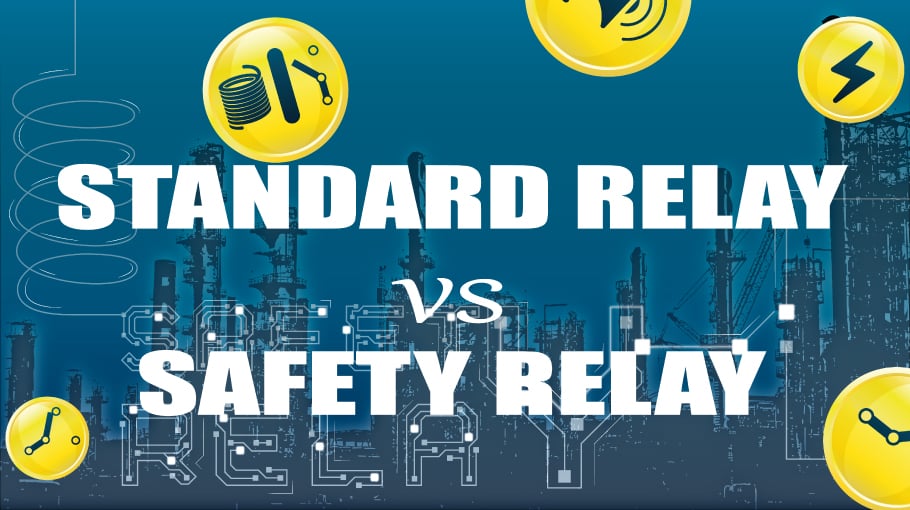Standard relays and safety relays are two distinct types of devices designed for different purposes, each serving divergent functions in electrical and industrial systems.
Making a brief comparison is not an easy task, as there are many points that require adequate consideration. However, the differences between a safety relay and a standard relay are encapsulated in the applications to which they are applied. On the one hand, there is a safety relay, which is mostly employed in safety-related applications. Its function is fundamental for performing the proper actions to drive the system into an unsafe state. On the other hand, a standard relay cannot be used in these conditions since its features do not permit its use in a safety instrumented system. This distinction justifies all the other differences, including the certifications and standards to which a safety relay is subjected, as well as the monitoring and mirroring functions which a standard relay does not have.
Function
The purpose of a safety relay and a standard relay is the first difference that we can highlight, and it can be defined as significant and distinct. A standard relay is widely used in general applications to switch control circuits. The function of a safety relay is to provide safety to specific safety functions and significantly reduce the possibility of fatal or dangerous events to personnel, assets, and the environment. It also safeguards the plant's normal operations. A standard relay is an electromechanical device used to control a circuit by opening or closing its contacts when it receives an input signal. It is typically used for general control and switching applications, such as turning motors on/off, controlling lights, or managing automation processes. A safety relay is a specialized relay designed to perform safety-related functions in industrial environments. It is used to monitor safety devices, implement safety functions, and provide safety interlocking and shutdown capabilities. Safety relays are essential for ensuring the safety of personnel and equipment in critical applications.
Safety Features
What we consider as a normal relay can be used in almost any automation application. It can also be used for industrial or civil engineering purposes without any peculiarity. Hence, a standard relay does not have any particular safety features and cannot be used in critical applications where a safety function is the core of the installation. Standard relays are not specifically designed for safety functions and lack built-in safety features. They do not have the necessary redundancy and diagnostics required for safety-critical applications. Safety relays are specifically designed with safety features such as contact redundancy, self-monitoring, and diagnostic functions. They provide enhanced reliability and meet safety standards to ensure the integrity of safety-related operations.
Fail-Safe Operation
A fail-safe operation is defined, in relation to an electrical system, as the ability of an apparatus to prevent unsafe situations of the normal operation of the control equipment in a failure condition. This does not mean, that the devices that provide this feature are fault-free but rather that, in case of any internal malfunctioning, the outcome is still a safe status of the application or at least it remains as safe as it was before the incident. Standard relays may not be designed to operate in a fail-safe manner. In case of relay failure, the circuit may remain in an unknown state. Safety relays are designed for fail-safe operation. In the event of a relay failure or loss of power, safety relays ensure that the output switches to a predefined safe state. This can be achieved by de-energizing or energizing the load depending on the safety functions it is associated with.
Certification and Standards
Most manufacturers, by now, have the fundamental duty to provide customers with certified products, regardless of the field they are involved in. Every industry has its own laws and regulations to follow, and the electronic industry is no exception. Depending on the target audience, application, and specific industry, such devices are subjected to specific standards, and third-party accredited bodies are responsible for ensuring that these components meet the requirements. Standard relays are generally not certified for safety functions and may not comply with safety standards. Of course, relay manufacturers have the duty to follow specific regulations, or else their products would not be available on the market. Safety relays are certified and comply with safety standards, such as IEC 61508, which defines the design standard for devices involved in functional safety. Moreover, safety relays undergo rigorous testing and evaluation to ensure their suitability for safety-critical applications.

Applications
Comparing these two instruments in the application sphere is actually something that may seem vague or ambiguous. The involvement of a standard relay in general applications is extensive, whereas the applications where safety relays are involved are limited to specified environments. Standard relays are used in a tremendous number of applications, probably in a higher volume than we can even imagine. They are present in our daily activities, and many times, we do not even notice their presence. Everywhere it is necessary to control, protect, or drive one or several circuits by an independent signal, relays are used. It is important to note that a standard relay can be used in various general control applications where safety is not a primary concern. Safety relays are used in safety-critical applications where personnel protection, machine safety, and process safety are paramount. They are commonly used in emergency stop systems, safety gates, light curtains, and other safety-related applications. Standard relays are used for general control and switching applications, while safety relays are specialized devices with built-in safety features and redundancy, designed specifically to ensure safe and reliable operation in critical safety applications. When safety is a priority in industrial systems, safety relays are the appropriate (often mandatory) choice to implement safety functions and protect personnel and equipment from potential hazards.
Color-code
This is probably not the most interesting thing to know, but still good-to-know. There is a visual difference between a standard and a safety relay, which can be noticed just by looking at these two devices, and it is related to the color code used by one of them. The standard relay is available on the market in a large variety of colors. There is no regulation or general rule that defines which color a standard relay has to be. The color can be decided at the complete discretion of the manufacturer. A safety relay typically has a yellow color or at least a yellow tag in the front panel area. This color-coding is intended to provide a quick and clear visual indication of the purpose of such a device. When the safety relay is installed, for example, into a large cabinet, it will be intuitive for the operator to immediately recognize that these devices are safety relays and are installed to execute a safety function. In some countries, instead of yellow, red is used.
Dimensions
The overall dimensions of a safety relay are usually greater than a standard relay. A standard relay does not have specific dimensions, and there are no specific requirements in this case for what it matters. The footprint of the device is decided by the manufacturer according to the needs that may depend on the market requirements. Usually, a basic model is quite small, or at least smaller than a safety relay. Safety relay, in most cases, contains different contacts which means multiple standard relays, complex electronic circuitry to manage, for example the diagnostic or delay function. Protections internal circuits to eliminate voltage spikes is also that is often present in a safety relay. All these distinctive traits necessarily requires that a safety relay has a larger case compared to a standard one.
Costs
As it is possible to imagine and based on the considerations that have been made so far, it is easy to acknowledge the fact that a safety relay is typically more costly compared to a standard relay. The factors that weight on the development and manufacturing of a safety relay bear drastically on the final market price. We have to consider that a safety relay requires a long design process since it has internal circuitry that is not present in a standard relay. Of course, the fact that a safety relay has diagnostic and protection circuits, multiple contacts for redundancy, etc., leads to higher production costs in terms of both components, manufacturing, and testing. Safety relay manufacturers also have to deal with certificates and take care of such processes in their entirety. Another aspect that cannot be overlooked is the market size. There is a tremendous difference between the commercial scale of normal relays, which are vastly used in a huge number of applications, and the circumscribed niche where safety relays are used.
Monitoring function
This term is strictly related to safety relays, and it is one of the main differences between this device and a standard relay. The monitoring function of a safety relay is often fundamental in the process industry or in any other field where constantly surveilling the health of the load and the status of the loop is a critical aspect. Standard relays do not have a monitoring function. Some safety relays are capable of monitoring the load and line or even their own internal operability. Not all relays are capable of such surveillance characteristics, but only the more advanced and sophisticated ones. The live monitoring of the health of the application can be achieved thanks to advanced internal electronic circuitry and can operate by constantly inspecting the internal operations of the devices and the loop integrity. It is worth mentioning applications for fire and gas where line monitoring is indispensable, since the load is usually inactive, and its intervention is required in case of emergency. This is a predictive method that safeguards the status of the loop and the load in a normally de-energized condition.
Pulse Test
What we are referring to here is the system with which the PLC checks the quality of the line that connects the DO card with the load. In case a safety relay is supposed to be added to such a loop because the digital output card cannot directly drive a safety load due to the required power, from the PLC card's perspective, the relay becomes the load. This functionality is nowadays used by most safety systems, but if the front end of the relay is not compatible with this function, it is possible to have chattering problems or even relay failure. The continuous opening and closing of the contact due to the test impulse brings the relay to a premature end of life. This is an important feature to consider when choosing a safety relay since it allows us to avoid damage to the relay contacts due to chattering, spurious activations of the load, and a premature end of life for the unit. The pulse test is usually performed by the DO card in both the on and off conditions. We have to take into account that we are talking about safety instrumented functions. If the safety relay is not compatible with the pulse test, it can lead to harmful situations for the application in general, causing malfunctions of the relay itself or false switching and triggering of unwanted safety procedures.
Fault mirroring
On some occasions, it might be necessary for safety relays to work along with supervised PLC digital output cards. In this case, the relay has to be one of those compatible with this feature and works as an extension of such functionality. Basically, in case a fault occurs in the output loop, at the coil of the safety relay, which is wired directly to the DO card, it is possible to detect a variation in impedance. This impedance can be read by the PLC card and interpreted as a fault condition. This is the reason this feature is called fault mirroring because the relay detects a fault in the field and mirrors such status on the coil terminals. This functionality also affects the installation and wiring costs, which decrease when a dedicated digital input card and the related wiring are no longer required. Standard relays do not have the fault mirroring function.
Communication protocols
A widely used communication protocol in the process industry is the Modbus protocol, and some relays adhere to this choice. The safety relays with this feature are usually the ones that we already defined as smart relays. This is because they are the ones that usually require settings and configuration and are capable of diagnosing the integrity of the application. All relay modules that support Modbus communication over an RS-485 cable can be used to create a network of up to 127 devices. These apparatuses can be arranged in a multi-drop network and monitored or configured by a single master unit. Each relay, which in this case can be seen as a slave, contains a table of parameters: each of them is uniquely identified through an address and, when requested, makes its value available for reading and writing. There are a series of benefits related to having a flexible communication protocol:

- 1 Modbus interface for all connected relays
- Multi-drop connection, communication up to 1200 meters
- Up to 127 relays in the same network
- No need of System DI for alarms monitoring
- Information about fault type
Temperature Operating range
Every time we talk about a safety relay, one of the features that is often underestimated is the operating temperature range. For some reason, many users overlook evaluating the temperature in the cabinet or the installation in general and comparing it to the specified range within which the safety relay is capable of operating. In fact, the temperature operating range that each manufacturer claims on any official document is certified information. The safety relay must be assessed and approved by third-party agencies accredited to release valid certificates. Most of the safety relays currently on the market have a wide operating temperature range to allow installation in harsh environmental conditions. Of course, this might not be enough, and a good practice is to consider a properly sized cooling system. The combination of these two elements extends the average life of the device, as by stressing the internal components less, we incur a lower risk of component failure and a longer average lifespan.
Conclusions
What we have been seeing so far is an extensive list of differences between a standard relay and a safety relay. There are numerous dissimilarities, and of course, there might be some other singularities that should be analyzed depending on the circumstances, but the distinction is clear and outlined. In all those applications where a relay plays an essential role in the prevention of hazardous events, the use of a safety relay is fundamental.


